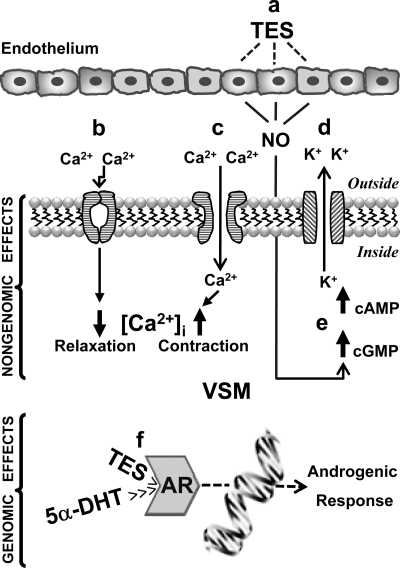Fig. 1.
Genomic and nongenomic mechanisms of action of androgens in the vascular smooth muscle (VSM) cell. a: Endothelium-dependent mechanisms, presumably involving endothelium-derived relaxing factors, particularly nitric oxide (NO), would seem to be responsible for the relaxing effect of testosterone (Tes) at physiological (<100 nM) but not at supraphysiological or pharmacological (>100 nM) concentrations. The incremental increase in cGMP reflects NO production, which induces vasorelaxation. Likewise, Tes and its metabolite 5β-dihydrotestosterone (5β-DHT) at pharmacological concentrations (>10 μM) induce endothelium-independent relaxation. b: Tes shares the same molecular target as the dihydropyridines [the α1C-subunit of L-type Ca2+ channels; voltage-operated Ca2+ channel (VOCC)] to elicit a powerful and direct channel blockade at physiological concentrations (36 nM) (17, 58, 59), restricting extracellular Ca2+ entry and diminishing intracellular Ca2+ concentration ([Ca2+]i) in the VSM cell to induce vasodilation (relaxation). 5β-DHT, a much weaker androgen than Tes, is a pure VOCC blocker at a broad range of concentrations (from nanomolar to micromolar) (41). c: Tes but not 5β-DHT, at pharmacological concentrations (above 1 μM), activates VOCCs, increasing extracellular Ca2+ entry and increasing [Ca2+]i to induce vasoconstriction (contraction) (41). d: Tes at supraphysiological concentrations (>100 nM) activates voltage-operated K+ channels or large-conductance Ca2+-sensitive K+ channels, increasing K+ efflux to induce VSM hyperpolarization and vasorelaxation (8). e: Tes but not 5β-DHT at pharmacological concentrations (>30 μM) is capable of increasing cGMP and cAMP production (8, 41). f: Genomic actions of Tes and 5α-DHT are mediated by the cytosolic androgen receptor (AR). 5α-DHT has the highest affinity for the AR and mediates many androgenic effects, whereas 5β-DHT has little affinity and is without biological effects (14).

